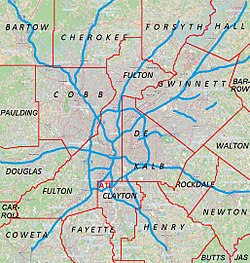Covington, Georgia
| Covington, Georgia | |
|---|---|
| City | |

Built in 1884, the historic Newton County Courthouse located in Covington, Georgia
|
|
 Location in Newton County and the state of Georgia |
|
| Location of Covington in Metro Atlanta | |
| Coordinates: 33°36′N 83°52′W / 33.600°N 83.867°WCoordinates: 33°36′N 83°52′W / 33.600°N 83.867°W | |
| Country | United States |
| State | Georgia |
| County | Newton |
| Area | |
| • Total | 13.9 sq mi (35.9 km2) |
| • Land | 13.8 sq mi (35.6 km2) |
| • Water | 0.1 sq mi (0.3 km2) |
| Elevation | 741 ft (226 m) |
| Population (2012) | |
| • Total | 13,347 |
| • Density | 970/sq mi (370/km2) |
| Time zone | Eastern (EST) (UTC-5) |
| • Summer (DST) | EDT (UTC-4) |
| ZIP codes | 30014-30016 |
| Area code(s) | 470/678/770 |
| FIPS code | 13-20064 |
| GNIS feature ID | 0355354 |
| Website | The City of Covington official site |
|
Covington Historic District
|
|
| Location | Roughly Covington City S of US 278, Covington, Georgia |
|---|---|
| Built | 1822 |
| Architect | Bruce and Morgan; Golucke, J.W., and Company, et al. |
| Architectural style | Greek Revival, Second Empire, Italianate |
| NRHP Reference # | 98000969 |
| Added to NRHP | August 06, 1998 |
Covington is a city and the county seat of Newton County, Georgia. It is located 35 miles east of Atlanta, Georgia. As of 2012, its population was 13,347.
Covington was founded by European Americans and incorporated in 1822 as the seat of the newly organized Newton County. Covington was named for United States Army Brigadier General and United States Congressman Leonard Covington, a hero of the War of 1812. The city grew with the advent of the railroad in 1845.
In 1864, General Sherman's troops marched through during their March to the Sea. Although they looted the city, destroying numerous buildings, several antebellum homes were spared.
The Covington Historic District and the North Covington Historic District within the city are both listed on the National Register of Historic Places. The maps and materials describing these two districts are available for review through City Hall. The Covington Historic District contains Floyd Street and the downtown square. The North Covington Historic District contains North Emory Street and Odum Street as its hub. Both districts have an ordinance to preserve their character, regulating changes proposed for properties, and special permits may be required.
The Covington Mill Village is also a vital part of local history. The Starrsville Historic District, site of the historic settlement of Starrsville, is in the exurban area around Covington. The Newton County Courthouse, brick store, and Salem campground are separately NRHP-listed.
According to the United States Census Bureau, the city has a total area of 13.9 square miles (36 km2), of which 13.8 square miles (36 km2) is land and 0.1 square miles (0.26 km2) (0.72%) is water.
...
Wikipedia



